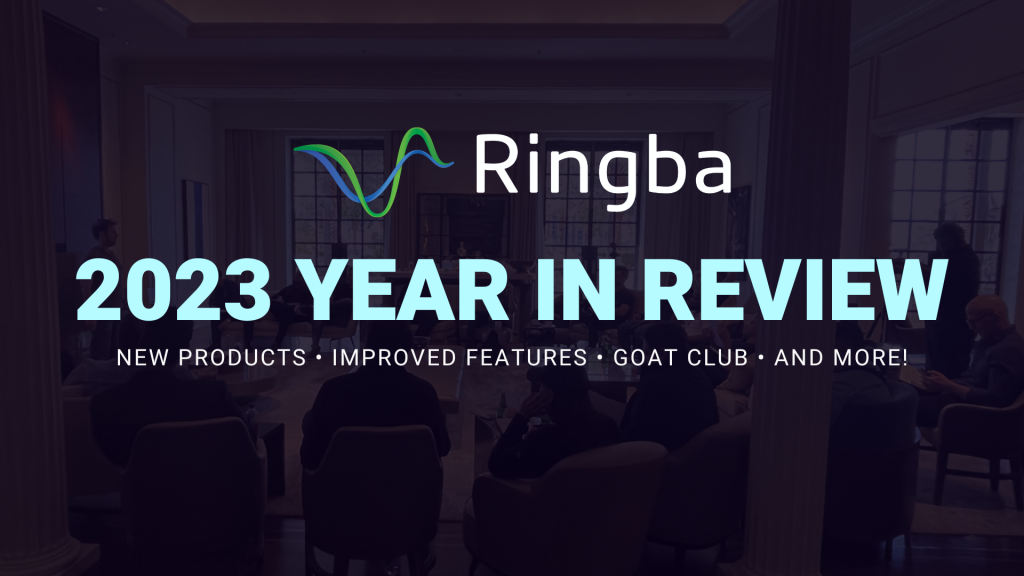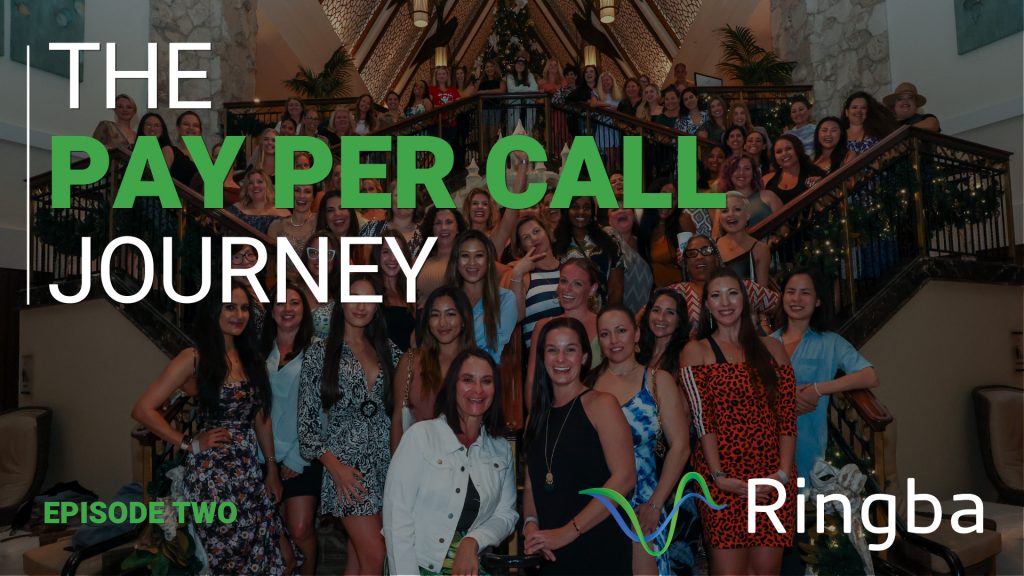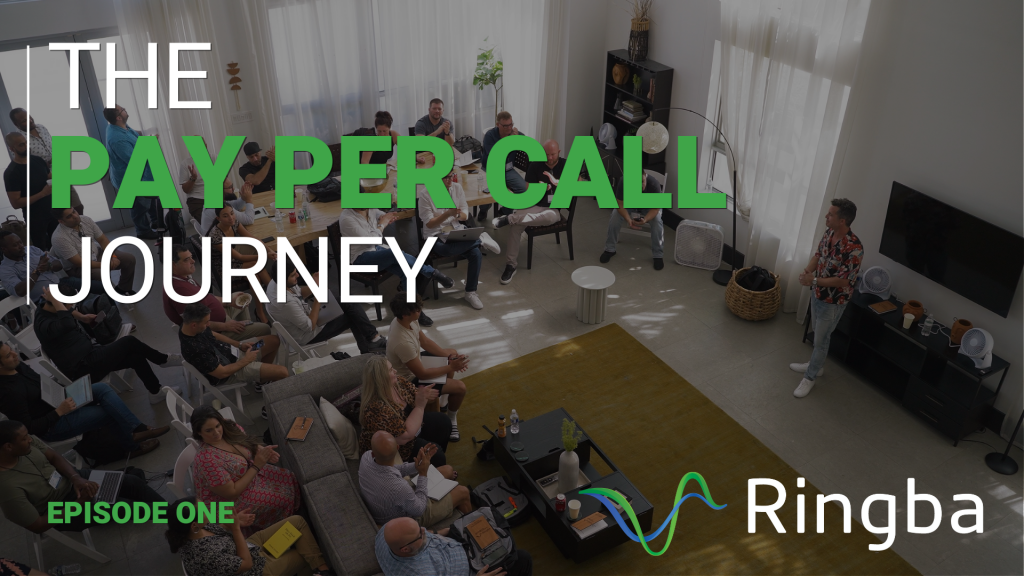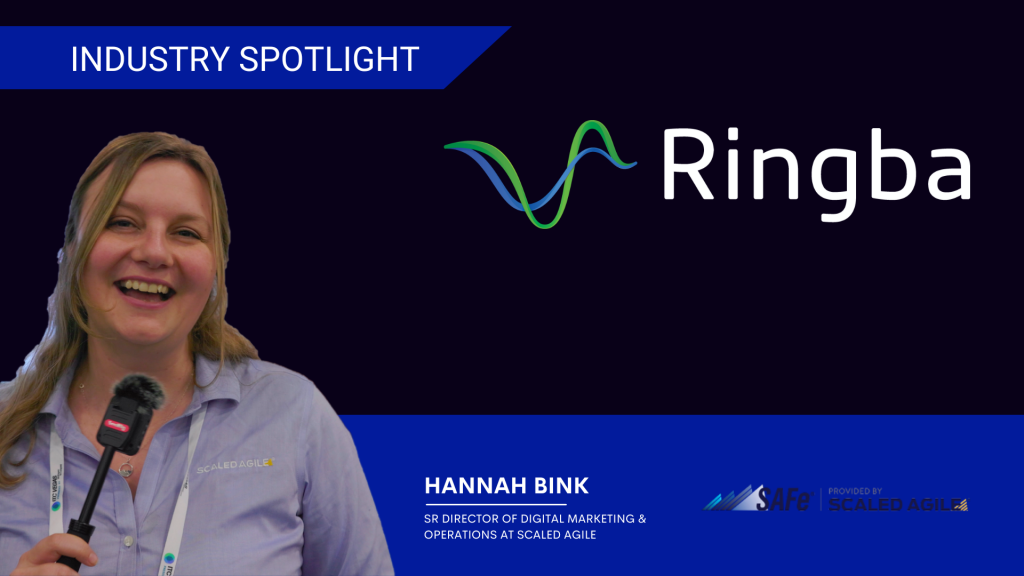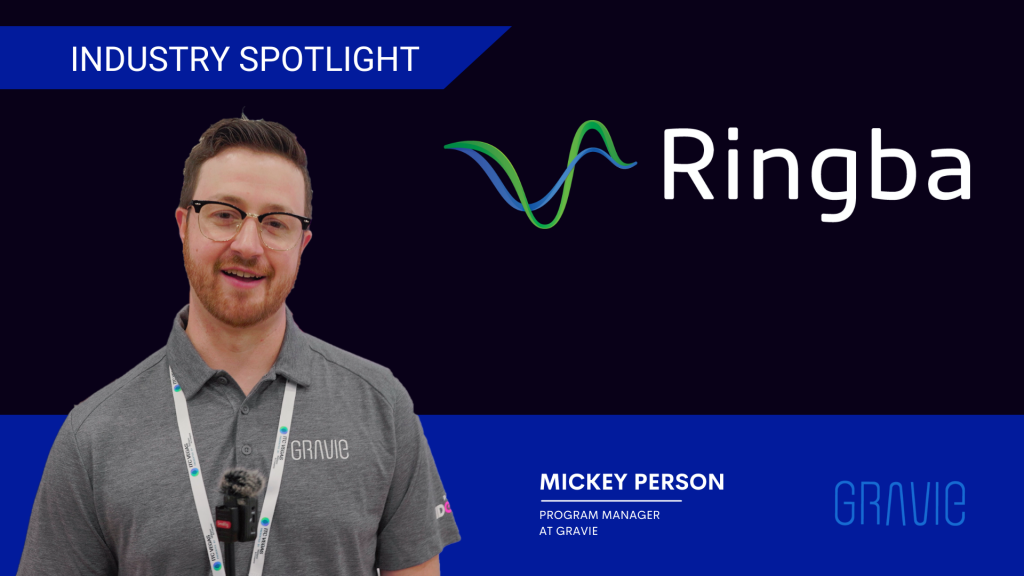Learn how to use automated call routing technology to improve conversions and optimize your inbound call flows.
Contents:
– Optimizing Call Flows with Automated Call Routing
– Maximize ROI by Prioritizing and Weighting the Flow of Calls
– Automatically Reroute Busy Buyers
– Reroute Non-answered Calls
– Simultaneously Dial Buyers and Sell to the First to Answer
– Duplicate Call Routing
– Geographic Routing
– Demographic Routing
– IVR Selection / Qualification Routing
– Routing Based on Hours of Operations
– Routing Based on Concurrency
Optimizing Call Flows with Automated Call Routing
The top players in Pay Per Call are all using technology to maximize their revenues. In this lesson, we’re going to break down all of the industry standard features that most companies are using to improve their ROI.
Each one of these features applies to almost every Pay Per Call Campaign and can be used alone, or in combination with each other.
Maximize ROI by Prioritizing and Weighting the Flow of Calls
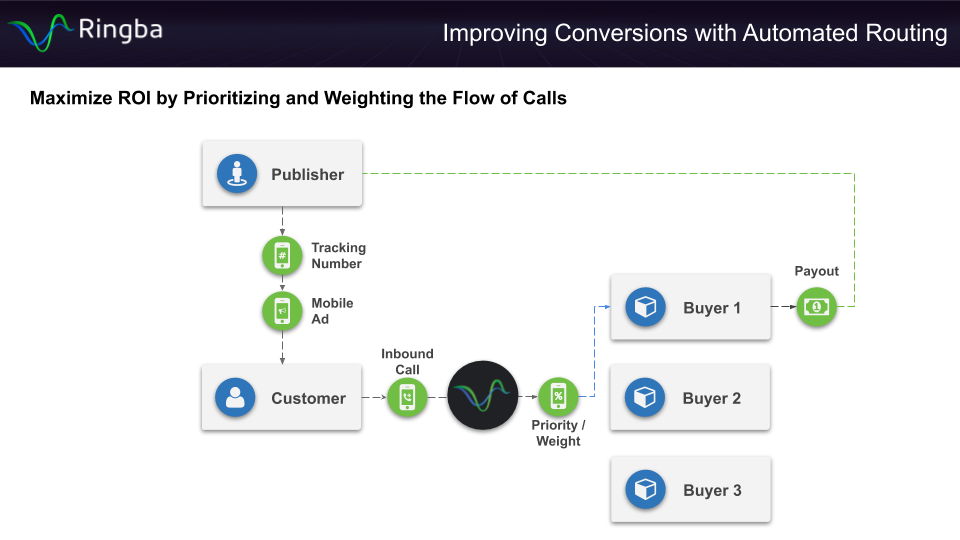
For whatever reason, you may want to prioritize specific buyers and lower the priority of others. Typically these are because maybe some are payment risks, or perhaps some have high error ratios and drop a lot of calls. It’s possible that some of them don’t convert as well, or maybe you have better relationships with some of those buyers, and you want to send them more calls because you see other opportunities.
There can be a million reasons why you want to prioritize some buyers and give some buyers different weight configurations. A publisher, or you perhaps, are going to get your tracking number, place your advertisement somewhere, probably on a mobile ad or a click to call ad. A customer is going to see that advertisement; they’re going to pick up a phone, they’re going to dial a number. That’s going to go through your call tracking platform, and your call tracking platform is going to prioritize the route of that call.
For whatever reason, buyer one had a higher priority than buyer two and buyer three, and so they got the phone call. Payout comes back from them to you. Whether there’s a network or a broker in there doesn’t necessarily matter a whole lot. The point is, for whatever reason, buyer one gets prioritized over the others.
If you’re not using your call tracking platform, you’re not going to be able to prioritize and weight your call flow so that you can decide where your calls are going. Mostly what you’re going to be doing is just taking the phone number from wherever you got it, whatever broker, network, or advertiser gave it to you, and only they are going to receive phone calls, and so you’re not going to have any control in that situation.
Automatically Reroute Busy Buyers
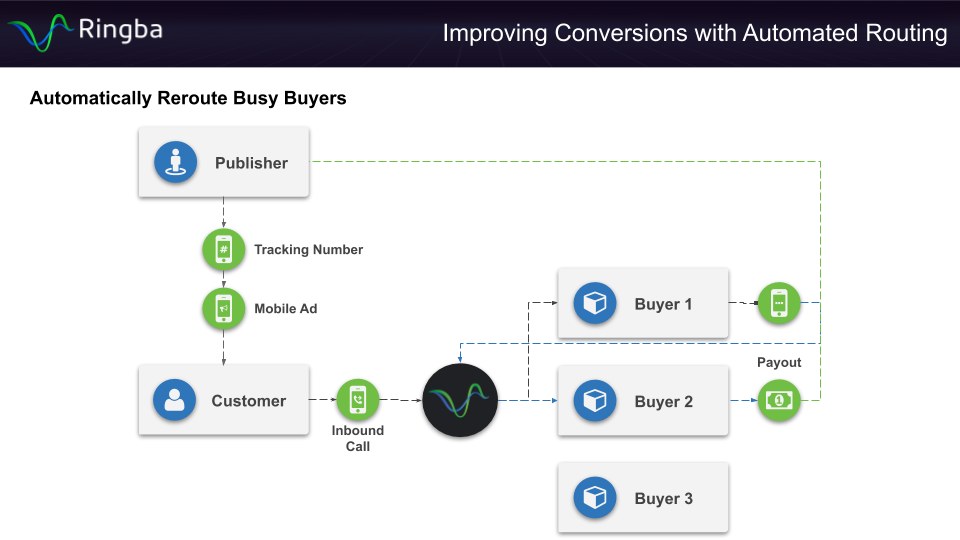
A busy buyer means when the customer calls, or your call tracking platform calls that buyer, they get a busy signal, and they don’t answer the phone. Now buyers will do this because maybe all of their agents actually are on the phone, or perhaps they just are working with a lot of different publishers and are overflowing their capacity on purpose, and whenever an agent’s not available they busy signal that calls so they don’t have to pay for it. When you’re working with a buyer that’s a call center, they want as many phone calls as they can get at any given time, and they want every single agent they have on the phone always because it maximizes the amount of money that they make.
One of the games a call center will play is they’ll go out to a bunch of different sources, maybe to their direct publishers, possibly to their brokers and networks, and they’ll tell those people that they have more capacity than they do. What happens is their agents are always full at all times. Then when they aren’t going to take a phone call, or they don’t have the capacity, they turn on a busy signal, and now you have to deal with that phone call.
If you have a call tracking platform, and you’re using Ringba, that’s not an issue at all. This game doesn’t apply to you. You’re not going to take any monetary loss or suffer any problems because of it.
If you’re working directly with a network, you are going to suffer because most of the time they’re going to get a busy signal, your call is going to drop, you have nowhere else for it to go. Now if you’re lucky, that network or broker has their platform, and they have other buyers in line for that phone call.
Most call tracking platforms out there, especially the big ones that power most networks, do not have sophisticated routing to handle errors and busy signals in a way that I consider the best way to do it. You’re going to run into this issue when you’re working with buyers, and that’s why it’s imperative to have your call tracking platform.
A publisher, or you, are going to generate this phone call using a tracking number placed on an advertisement. Then a consumer is going to see it. Now the consumer picks up their phone, and they call the phone number, it goes into Ringba, and Ringba’s going to dial buyer one. Now buyer one sends a busy signal, and immediately when that busy signal happens, in a fraction of a second, just a few milliseconds, we detect that busy signal and then immediately dial buyer two.
Reroute Non-answered Calls
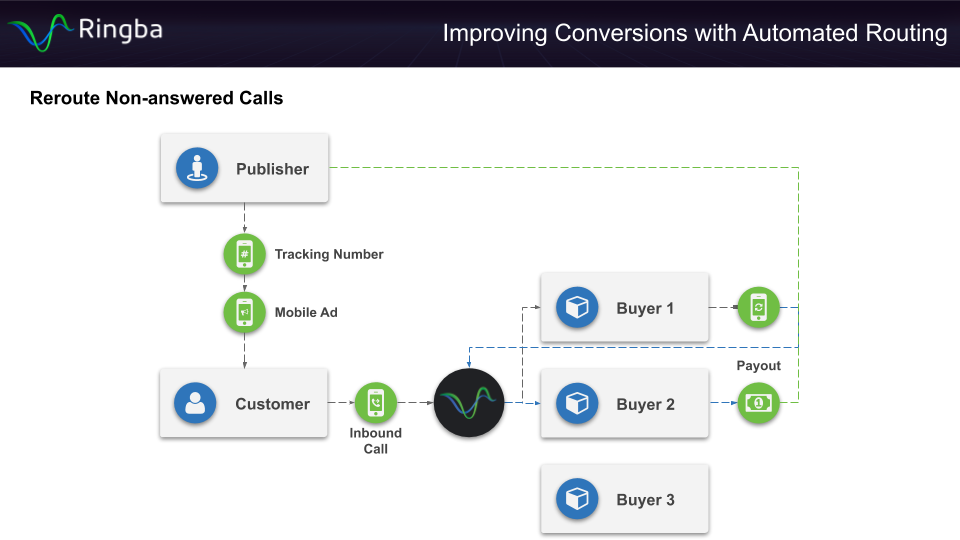
Next, we’re going to look at rerouting non-answered phone calls. What happens in this situation is very similar to the busy signal situation, but instead of hitting the phone call with the busy signal, which in a lot of cases is more preferential to you because that busy signal gives you immediate notice in real time that the phone call is not going to get connected. Some call centers do not have that capability, so instead of using a cue, what they will do is just let the phone call ring. They’ll make it ring, and ring, and ring, 30 seconds, a minute, whatever the case is. Because instead of bouncing that phone call with the busy signal, if it just rings, they still potentially have the opportunity to answer it if an agent becomes available.
In this situation, if you have a buyer that’s doing this, it’s essential that you’re billing them on duration from phone call ringing as opposed to the duration from answering the phone call if there are duration requirements. Duration requirements mean that no payout event happens until a specific duration of the call. Someone has been on the call for a particular length of time, like a minute, or two minutes, or whatever you and the buyer have negotiated.
What happens in this circumstance when the phone’s ringing, and ringing, and ringing, is consumers start to give up, and they hang up the phone, and then you don’t get paid for it. The buyer had an opportunity to answer the call that entire time, so they received value for that. They had the option to answer the phone call, and that’s the value they received. If one of their agents became available, bam, they answer the phone and then they can maximize the yield of their floor. This is why it’s super essential again that you have your call tracking, even if you’re working with networks and other buyers so that you can have control over this.
In this situation, you’re going to generate your phone call with a tracking number on an ad. The consumer calls, it goes into your call tracking platform, and now there’s a timeout associated with the ringing. Inside of the Ringba configuration on a buyer or target level, you can configure how long we’ll let the phone call ring until we reroute it to another buyer for you. Buyer one is ringing; maybe it’s five seconds you give them, perhaps it’s ten. It just rings, and then once that timeout period happens, you take the option away from the buyer, and we automatically reroute to another buyer that may be available. This is a way that you can recapture a significant amount of value in your call flow.
Simultaneously Dial Buyers and Sell to the First to Answer
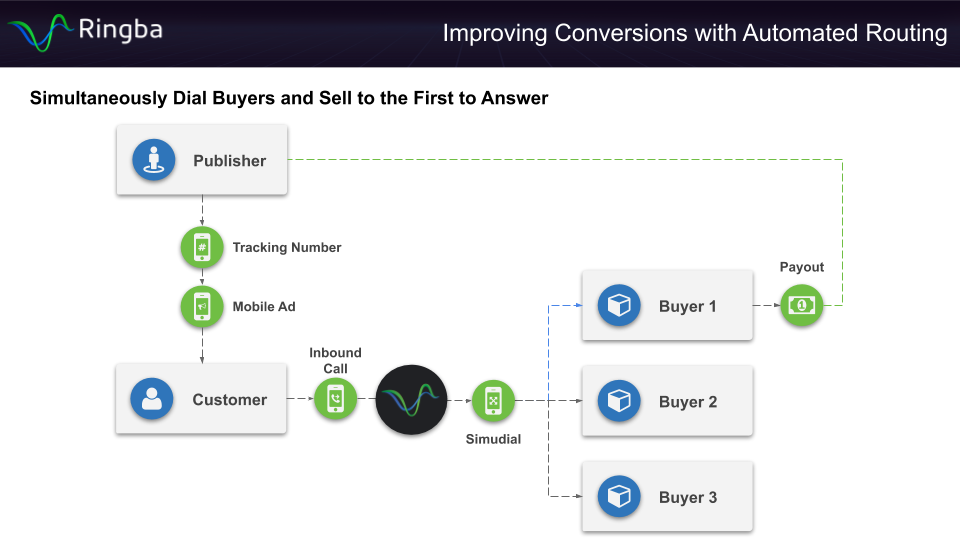
Let’s talk about simultaneously dialing buyers and selling to the first one to answer. Now there are a few reasons why you would want to do this, and there are a few downfalls to this as well, and we’re going to cover all of them.
Simuldial essentially means that we are going to dial all three buyers at the same time, or all five, or all 25, or all 600. It doesn’t matter how many buyers you have, we’re going to dial them at the same time, and the first one to answer the phone call gets it. This is a great way to maximize the number of calls that get answered. Depending on your requirements, your buyer requirements, and depending on how much each of the buyers is paying, this can be a lower return on investment scenario for you, depending on how you want to do it.
In more sophisticated call routes inside Ringba, you can simuldial a specific group of buyers, and then if they don’t answer, we’ll reroute the call based on how much other buyers are paying and a bunch of different criteria. This can become a complicated scenario, and you want to talk to your account managers about your options here. Let’s run real quick through what a simple simuldial situation looks like.
The publisher, or you, is going to take your tracking number, put it on an ad. A consumer sees that ad picks up the phone, calls. It routes through Ringba. Ringba simultaneously dials, so at the same time, concurrently, we dial buyer one, buyer two and buyer three. Now they all may start ringing. Buyer two may hit with a busy signal. Buyer three may have a technology error. We don’t know, maybe they just all ring and buyer one picks it up the fastest because they have a hold cue, and so no matter what they pick it up quickly. Then buyer one issues the payout for this phone call, whether it’s through a network or directly to you, or whatever the case is. The payout event happens if that call meets the conversion criteria.
Where this can get a little bit sticky is if your buyers have different geographic requirements or different campaign requirements in general, and you need to route by those. If all of your buyers take nationwide phone calls, this isn’t necessarily an issue. If half of your buyers only take west coast and half take east coast if you configure it this way it can be a problem.
It can also produce less money for you as well. If buyer one pays $10, buyer two pays $22, and buyer three pays $6, and buyer three is always the fastest to answer the call, this could be a costly situation for you. You need to take into account how much money all of the buyers are paying you, and what the campaign criteria are before you implement some simuldial routing plan on these campaigns.
If buyer one, two and three all take entirely national traffic, which means they’ll take a phone call from anyone, let’s say in the United States, or the US and Canada. Then let’s also say that they’re all paying essentially the same amount. Buyer one’s paying 10, buyer two is paying 10, buyer three is paying 10.25, which is mostly irrelevant. What we want to do is maximize how quickly the calls get answered so that we make the most money possible.
If your buyers are all paying you on a raw phone call, which means they pay you as soon as they answer the phone call, you would want to simuldial in that scenario, because realistically speaking you don’t care how good their salespeople are. You don’t care what the duration requirements are. You get paid on raw call, so you want them answered as soon as humanly possible 100% of the time if all the payouts are mostly the same. That’s the perfect scenario for a simuldial, is all the campaign criteria are precisely the same, and everyone’s paying you about the same, and they’re all paying you on raw call. That’s where you could make a lot more money with simultaneously dialing your buyers.
Duplicate Call Routing
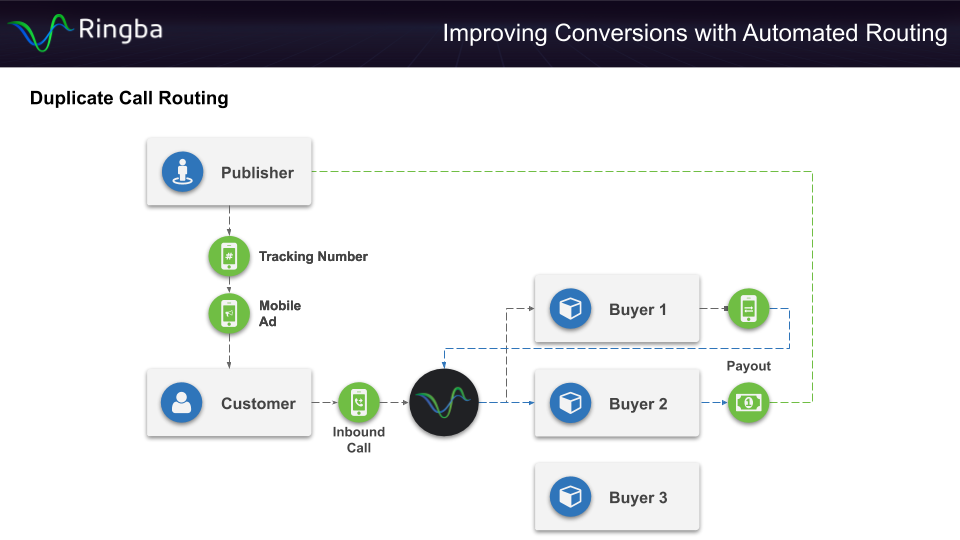
A duplicate call is when a caller picks up the phone, dials it, calls, they get connected with an agent. Then they pick up the phone, they dial it, and they call again. You could make a lot of money by managing your duplicate call flow properly. If you’re working with a network and you do not have your call tracking, you have no control over this, and the network like 98% of the time, or even higher than that, are not going to pay you for a duplicate phone call.
That sucks because based on the statistics in our platform across hundreds of different verticals and industries, we typically see on the low end at least 5% duplicate calls, and on the high end sometimes up to 25% duplicate calls. If you think about that, anywhere in that range, whether it’s low or high, if you could monetize all of those or a percentage of those phone calls, that’s nothing but pure profit in your pocket. You need to manage your duplicate call flow appropriately, or you’re just leaving a ton of money on the table.
Geographic Routing
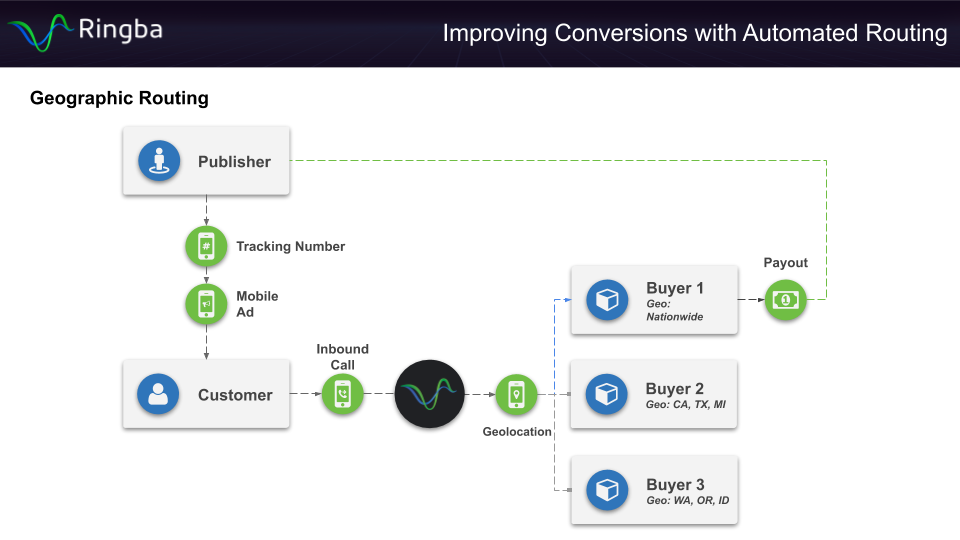
What happens here is a publisher, or you, generates a tracking number, you place your ads. Consumers see it; they pick up the phone and dial. It goes through Ringba. Now, buyer one bought this call the first time.
Let’s assume for a minute that they bought it, they paid for it, and you got that money. Now for whatever reason, the consumer called back. Maybe they’re looking for auto insurance, and perhaps they talked to someone at buyer one, and they were not happy with how they were treated by buyer one, or the guy they were talking to was new, or the agent didn’t do a good job, or whatever. I mean, there’s an endless list of reasons on why someone would call, talk to someone, and then pick up the phone and call the same phone number. Either way, they weren’t taken care of properly. That’s not your fault. That’s not your problem.
If you generated a legitimate phone call using legal advertising, and the call center didn’t close that person, that’s it. That’s their fault. That’s their problem. You have a recording of it because you’re using your call tracking, so if there’s a dispute, you have proof that it was legit and all that good stuff.
The consumer picks up the phone and redials your tracking number. Now again, if you’re working with a network, you’re just not going to get paid for it, but they’re going to get the phone call, and they’re going to route it somewhere else. With your call tracking, you’re going to route that duplicate call in milliseconds automatically. We look and see if the person’s called before, and we route them to buyer two. Now buyer two has no relationship with this caller, they’ve never seen their caller ID before. As far as they’re concerned, it’s a new call. They talk to the person, it converts. Maybe they sell them; perhaps they don’t. Again, not your problem, and a payout is issued.
In this scenario with a duplicate call, when adequately managed, you get paid twice, or sometimes three times, four times, five times. We’ve seen duplicate call routing plans remonetize the consumer five, six, seven, eight, nine, probably more in some limited circumstances, times. That means the person that configured their duplicate routing rules is maximizing the value of these repeat callers and then taking the ability away from the broker or network to do this same thing. I think that’s the most crucial part.
If you use duplicate call routing and you’re working with networks or brokers, that alone will pay for your call tracking platform. I want to let that sink in for a second. If you only use duplicate call routing, in almost 100% of scenarios, this alone will pay for your call tracking. Then everything else you do with it, all the other money you make with it, and all the control you get with it, is all just profit, it’s gravy. That’s why this type of methodology with using your call tracking, even if you’re an affiliate, or you’re a network, whatever the case is.
Demographic Routing
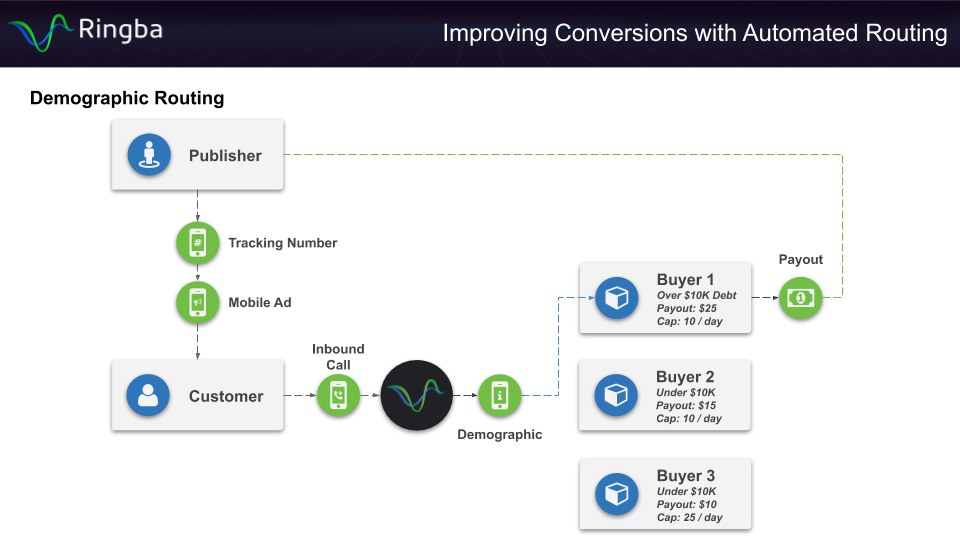
Demographic routing can mean routing by a whole bunch of different things. I was at a trade show recently, and I spoke with a woman who runs recruiting for a major university. They were concerned about how they fill specific demographic buckets. With universities, they’re required to enroll a certain percentage of people that come from a different ethnic background. That’s the law on universities, and they struggle with this because they don’t necessarily understand how to do that. Then how do you track your inbound phone calls to the recruiting office and sort them by demographic and deal with all that? It’s a complicated problem.
There are also other types of demographic indicators that specific campaigns require. In this example right here, we’re talking about a debt consolidation company, and they only want to buy phone calls from people that have more than $10,000 in unsecured debt. That gives them a lot more wiggle room for their product. You know, if someone only has $500 in debt, how much can you charge that person to solve the problem? Not a lot, because it doesn’t work that way. If they have $40,000 in credit card debt, charging them $500 or $1000 to help them clean it up isn’t that big of a deal. That’s why they want people with more debt. A lot of the time in the debt space you have attorneys that are doing this, and they don’t want to sue and deal with all the court fees and all the nonsense for only a couple hundred bucks. They need people who are better candidates, that have better demographics for their specific campaign.
This can apply to anything. It can be rich people, poor people. It can be people that work in different job types. It can be people of varying age groups. It can be people who like different things. Demographics can be a vast assortment of qualification criteria.
Let’s talk about the debt example first, and then we’ll talk about what you can do theoretically with technology. In this example we have a publisher, you, that is taking their tracking number, placing it on an ad somewhere. A consumer calls that ad, it goes through Ringba, and we qualify this person for over $10,000 in debt. Now, how do you do that? A lot of the time it’s done with interactive voice response. It’s going to say, “Thank you for calling Debt Busters. Please press one if you have more than $10,000 in debt. Please press two if you have less than $10,000 in debt.” Whatever those options are. In the debt scenario, a lot of times this is done with IVR, but it’s still considered a demographic. You’re always looking at some qualification criteria to get this person to the right buyer.
Let’s say the caller has more than $10,000 in credit card debt and they selected that through an IVR. Buyer one here in this example, they’ll take over $10,000 in credit card debt or unsecured debt. They’re going to pay $25 for that, but they can only take 10 per day. A lot of the times with your buyers, they’re only going to buy so many calls from you per day, per week, per month. Now, this can be because at first, they want to assess quality, so you should expect that a new buyer is only going to give you a limited amount of capacity because they have to have actual humans answer the phone. There’s a risk for them to take those phone calls.
Buyer one, they liked the call. They make the payout to the publisher. Maybe it goes through a network, and perhaps it doesn’t. Now if this person selected that they had less than $10,000 in debt, we’d automatically route that call to buyer number two or buyer number three, depending on the payout, or their capacity, or whatever. If I’m looking at this specific example, obviously I’m going to want buyer two to take that call because they’re paying an additional $5. Once they cap out, once they’ve received their ten calls a day, then it automatically gets routed to buyer three, and we’re getting $10 a call. Maybe that breaks even and allows us to keep running the campaign, maybe $10 an appeal is still profitable. Whatever the case is, that’s how you kind of waterfall your routing in a demographic based environment.
Now, if you’re using our number pool technology, that’s where you can get sophisticated with demographics. If you’re creating social ads on Facebook, or you’re getting your demographic information from your traffic source, with number pools you can pass that data to your landing page. We’re going to grab that data about the user, and then you can make routing decisions by that data.
If you have an advertisement that targets low-income people, for instance, you can actually flag that, tag it as it comes into Ringba, and then route by that information. If you’re running specific advertisements like the university example, where you need to know the ethnicity or the background of the person, let’s say they submit a lead, and inside that lead, they’re selecting their ethnicity, you can then pass the lead data into Ringba.
IVR Selection / Qualification Routing
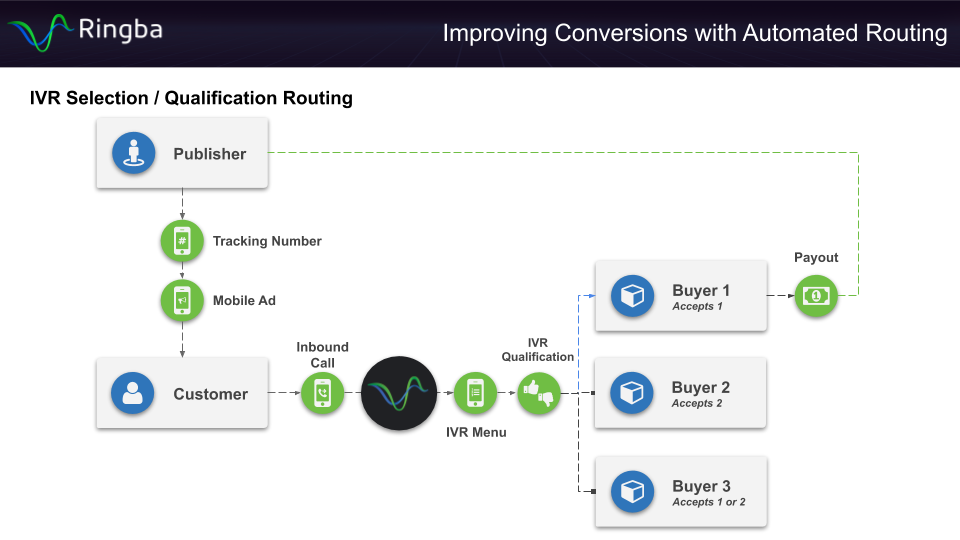
IVR is an interactive voice response. It’s one of those prompts that you get when you call customer service, and it’s like, you know, for an issue with your phone service, press one. To talk to the billing department, press two. Now in Pay Per Call it typically sounds like, for sales, press one. For customer service, press two. They want to filter off the customer service calls and route the sales one directly into the sales call center.
Ringba has some incredibly IVR features built into our drag and drop interface. You can create an extremely complicated IVR in our system in just a matter of a few seconds. Where, if you’re using someone else’s, it can take you a long time, or maybe you can’t even do some of the functionality.
We also have text to speech in 15 different languages, male and female. If you want to take your campaigns overseas, or you want to make these things fast without going out and doing a bunch of professional recordings, which take time, our system’s super flexible and allows you to do that.
Let’s say you’re driving a phone call, and you’re using a tracking number, it’s shown on an ad. A consumer picks up the phone, dials that phone, routes through Ringba, and it hits an IVR menu. It says, “Thanks for calling. Please press one for sales, press two for customer support.” They press one; it goes to one of these buyers. Bam. The buyer gets it, makes a payout. For whatever reason, it goes to buyer one. That’s a simple IVR example.
Now in most cases, it’s going to be more of a qualification scenario. If we use the debt buyer example that we did on the last slide, the debt buyer is going to ask, “Do you have more than $10,000 in credit card debt, or do you have less than $10,000 in credit card debt?” That IVR is going to sound like this, “If you have more than $10,000 in credit card debt, please press one. If you have less than $10,000 in credit card debt, please press two.” In this scenario, based on the buyers, buyer one accepts one, buyer three will take one or three, and buyer two accepts two. Buyer two wants people with less than 10k in debt. The other ones wish to people with more, or buyer three will take either, and are most likely going to pay you different amounts of money based on what that IVR qualification is.
In Ringba, one of the cool things you can do is for every single IVR selection, let’s say for more than $10,000 in credit card debt, you can do routing by that, different payouts by that. All by the user’s selection, which is cool. Then if they have less or they press two, you can route it on a different routing plan with different payouts and different demographic routing, and all that good stuff, all based on what the consumer puts into their system.
Now let’s say they press two for support. You run that person into a voicemail. We have that; it’s not an issue. They press two if you want you can disconnect the call. There’s an endless amount of options that you have with IVR. You can fire a pixel when someone presses a different prompt, and then post all the data in our system out with that pixel to a CRM. You can do all sorts of exciting things with IVR once you understand how this works.
Sometimes what happens with IVR scenarios is you qualify the customer, but you do not have a direct relationship with buyer number one. Let’s say that buyer number one is going through a network, and the network has their IVR in there and refuses to remove it because they’re like, that’s how we qualify customers. What you hear a lot of the time, for people who aren’t aware, is they go through one IVR, and then they’re asked the same questions again in another IVR. That pisses the consumer off. It’s just stupid. It doesn’t do anyone any good, and it drastically removes the conversion rates. A lot of times the networks or the buyers don’t care because maybe they don’t have the facilities in place to run quality assurance to make sure that someone’s not defrauding them by just sending anybody in without that IVR qualifier.
What you can do with Ringba is you can automatically dial the selections in your buyer’s IVR so that the users don’t hear them. Then what happens is they come in, they listen to your IVR, that person presses one because they have more than $10,000 in credit card debt. Ringba automatically connects the call to buyer one, makes the IVR selections, you tell it to, and then the consumer is connected without that IVR, and you get the higher conversion rate because the consumer did not go through multiple IVR trees.
Routing Based on Hours of Operations
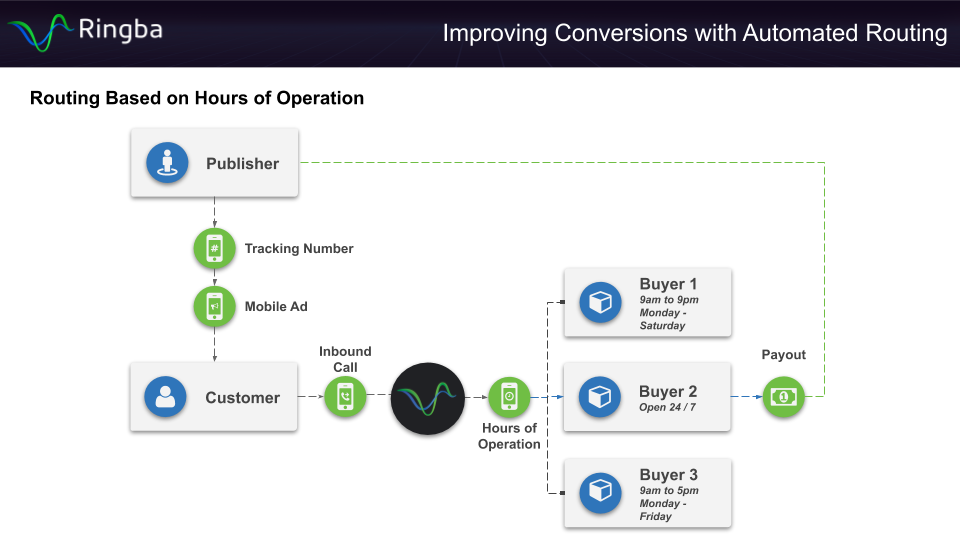
You generate your tracking number; you place it on an ad. A consumer picks up the phone and calls, and Ringba takes a look at the hours of operation of all your buyers. If any of those buyers get closed, we don’t send a phone call to them. Because if they’re closed, they’re not going to answer it. They’re going to let it ring, and ring, and ring, or they’re going to bounce it, or they are open, they’re going to take the phone call and sell it, and then they’re going to say, “Well publisher, we’re not paying for this because you sent us a phone call after 6:00 PM.”
That is something also to be aware of. One of the ways a network can make money is they can tell you the hours of operation are for 8:00 AM to 6:00 PM when they’re 8:00 AM to 7:00 or 6:30 PM. Then once that 6:00 PM cutoff happens, any remnant traffic or callers that come in after the cutoff, they still get paid for and you do not. That’s what arbitraging the hours of operation look like. That’s why it’s imperative you have, again, your call tracking so that when a call comes in you follow all of the buyer’s rules and criteria to make sure that you get paid for all of your phone calls. That’s what the independent call tracking is about, and it’s so you can keep everybody honest.
Let’s say it’s one in the morning, and someone calls in. Buyer one’s only open from 9:00 AM to 9:00 PM Monday through Saturday. Buyer three is only open from 9:00 AM to 5:00 PM Monday through Friday. Buyer two is open 24/7, so it doesn’t matter what the payout is, if everyone’s closed it goes to whoever is available and open. Very simply. A payout happens. Maybe it comes through a network. Perhaps it doesn’t. Maybe it goes through a broker. Perhaps you’re direct with the buyer. It doesn’t matter. Payout is issued, you get paid.
Routing Based on Concurrency
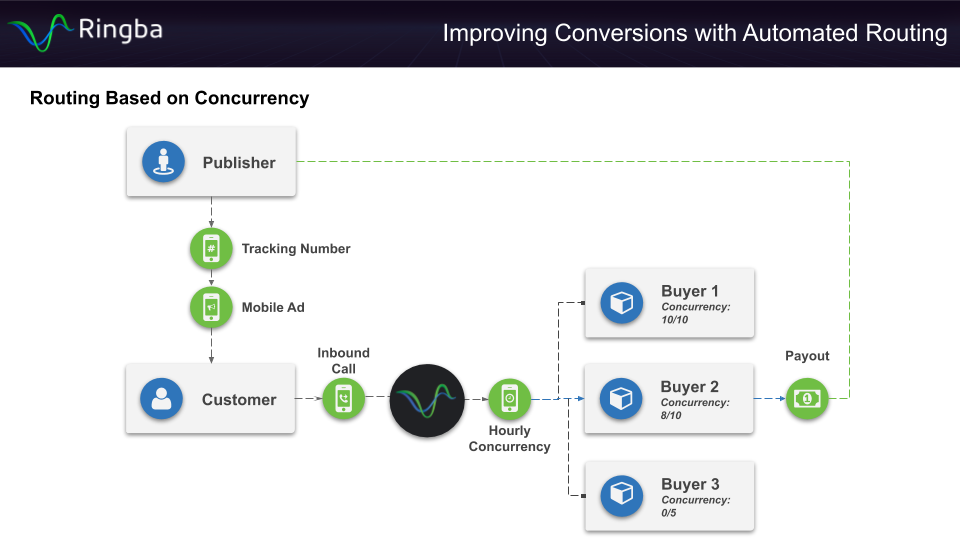
I find that the more brokers or networks a call flow goes through, the fewer people are on top of their capacity and their concurrency. It’s a lot to manage, and if you’re talking to a buyer through a broker that’s going through a network, and you’re talking to the network account manager, they’re not getting real-time information from their buyer. They’ve got to go through a broker too. Maybe the buyer’s not responsive. You run into an issue of capacity, which is the number of concurrent calls that can go to a buyer at any given time. That’s why, if you’re going to maximize your margin, eventually making direct relationships with buyers is going to be how you make the most money. Not necessarily because they’re going to pay you more even, but because you have that direct line of communication and you can adequately load balance your call flow.
When someone talks about load balancing their call flow based on CC, or concurrency, especially in the chat, they’re going to call it CC. They’re talking about the number of simultaneous phone calls that someone can handle at any given time. If a publisher says, “Hey, I’ve got 50 CC of auto insurance phone calls.” That means they have 50 people at all times on the phone, talking to auto insurance salespeople. If a buyer, for instance, says that they can handle 20 CC, that means they have 20 people available at any given time to take 20 simultaneous concurrent phone calls.
You always want to ask if you’re working with a network, what the concurrency is. If anyone ever tells you, “Oh, we can take unlimited.” That’s not how a call center works. Call centers have people in them, and they need people to answer the phone. Now, let’s think about this for a minute. To take unlimited phone calls, you have to have countless people.
That’s not possible, but let’s assume for a minute that you could take a whole, giant amount of extra phone calls. What does that mean? That would mean that you have, I don’t know, 50, or 100, or 1000 humans are sitting around, doing nothing, getting paid for it, waiting around for a phone call to happen. Now, the most expensive part of any call center is the labor; it’s the humans. The number one thing that any call center wants to fix is their call flow efficiency, and that means that for sales they want 100% of their salespeople on the phone at any given time, so that they make the most money per call, per sales agent, they possibly can.
Very few call centers run at 100%. I don’t even know if it’s possible. The best I’ve ever seen is people reach the 90s simply because it’s hard to manage call flow. When you’re talking to a network, like I said, and they say, “Yeah, we have unlimited. We can take as many as we want.” That is a recipe for disaster because you’re going to send a whole bunch of phone calls in there, they’re not going to get answered. You’re not getting paid for it. The network doesn’t care, because if the phone call doesn’t get answered and they don’t get paid, you don’t get paid. Of course, the network’s going to say, “Yeah, send as many phone calls as you can.” Because well, if it doesn’t get paid for, that’s your problem. It’s not theirs. It’s essential to understand the interests and alignments when you’re working with these companies.
The publisher, they get their tracking number. A customer calls it, Ringba’s going to take a look at how many concurrent phone calls all the buyers have. You can configure the concurrency of a buyer flat, you can say they can take 10 CC at all times, or you can set their hourly concurrency by day, which is the best way to do it.
The best way to configure your concurrency if you’re running calls to multiple buyers, is on an hourly basis, especially if you’re direct with those buyers. Because call centers operate like any other business, humans got to take the calls, right? What do humans do? They use the bathroom, and they eat stuff. At noon, lunch hour happens, and a lot of call centers do not run 15-minute shifts. They don’t have people starting every 15 minutes. They run a shift like a regular business. They have them come in at 8:00 AM, or noon, or whatever it is. There’s going to be fluctuation in the number of humans available to take those calls, based on the hours of the call center’s operation.
If you want to be smart about this, what you want to understand is, okay, Monday through Friday, what’s your schedule look like? How does your concurrency change? The call center’s going to say, “Oh, well, maybe at noon is lunch hour, we lose 20% of our capacity. Shift change is at 2:00 PM, we get a lot more capacity then. Then at 7:00 PM, half the agents go home. We still want phone calls until 11:00, but we have half the capacity.” What you’re going to find is that most people aren’t asking these questions to their buyers, and so they get a lot of no answers, they get a lot of rings or busies, or whatever, because they don’t understand the scheduling of their buyers.

